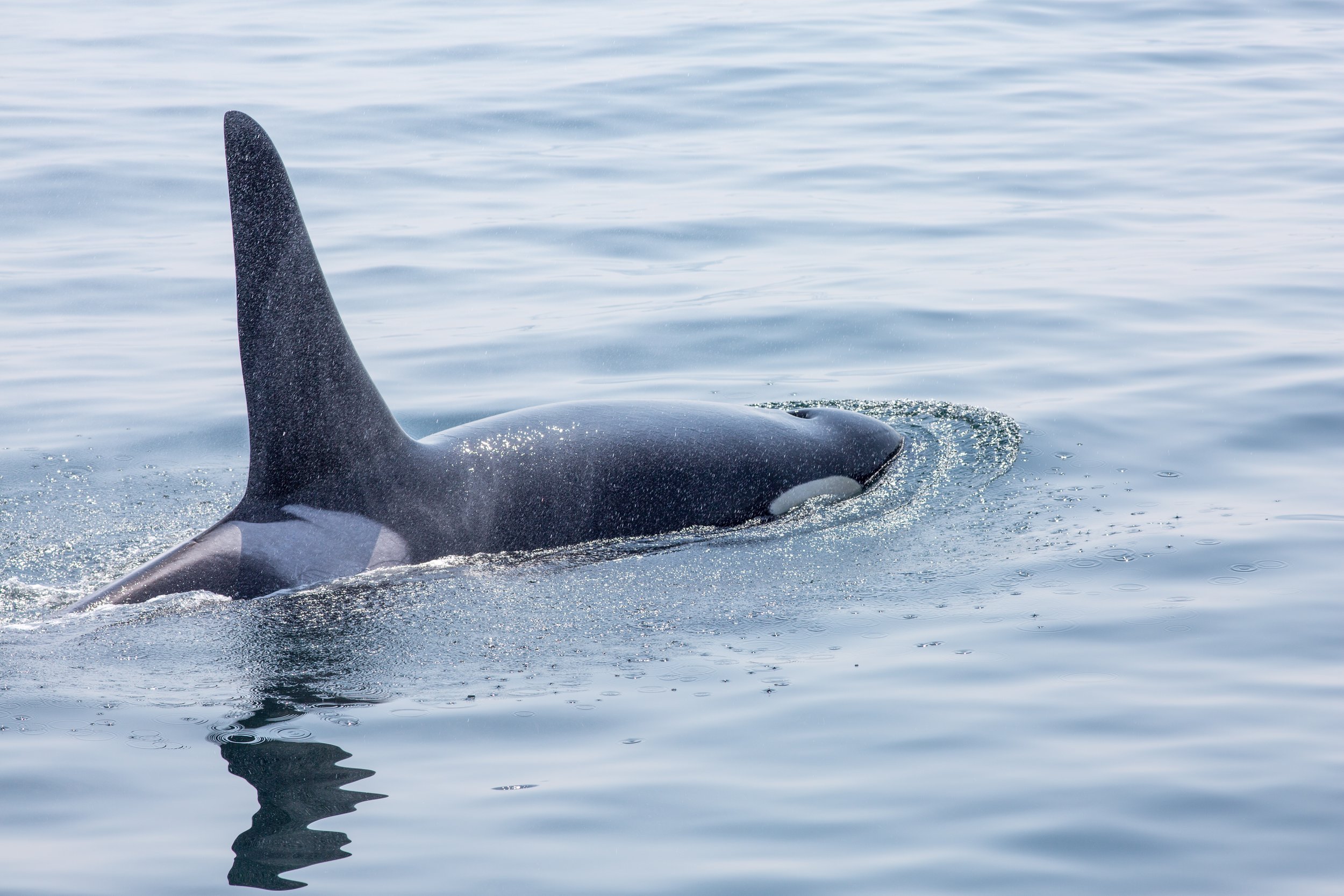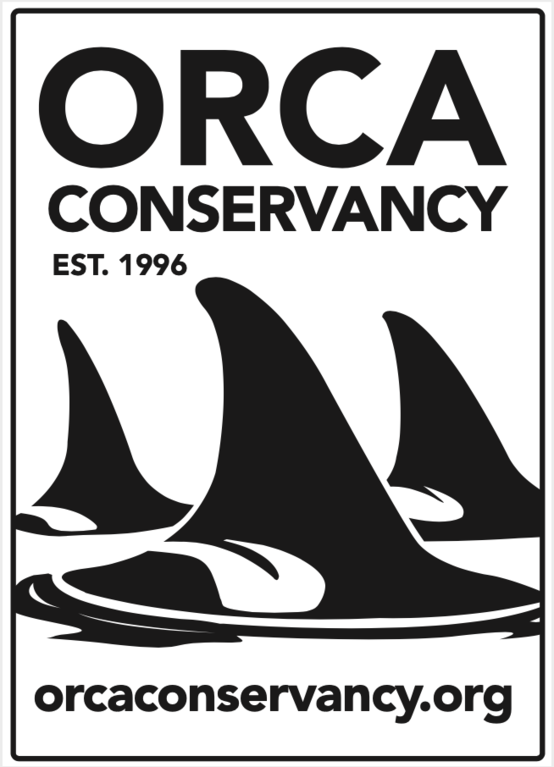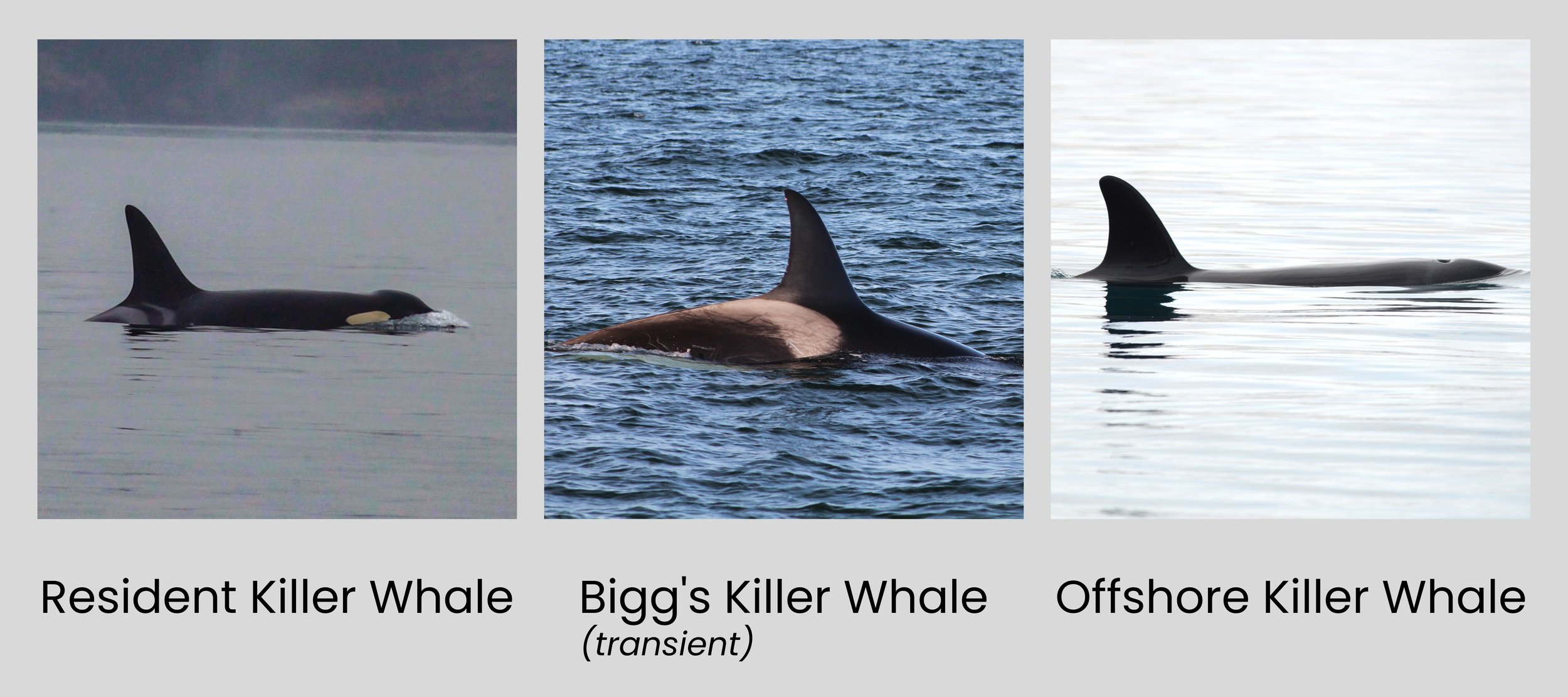
The killer whales of the Pacific Northwest
The three ecotypes
Many people are often surprised to learn that there are different types of orcas. There are several distinct ecotypes that are genetically, physically, and culturally different. Within the range of the Salish Sea, there are three ecotypes of killer whales, the Resident, Bigg’s or Transients, and Offshore. Each one of these ecotypes have completely different dialects, and hunting behaviors, and they do not intermingle nor interbreed.
-
Diet is exclusively fish, with the majority consisting of salmon, specifically chinook salmon. Medium-large in size, (23.6 ft / 7.2 m) with a black and white form. Dorsal fin shape is rounded at the top with a pointed trailing tip. Saddle patches can be both open or closed, with a more white pigment. Travels in large pods of intermediate and extended family.
-
Mammal-eater with diet consisting of seals, sea lions, porpoises, dolphins, and whales. Large in size, (26.2 ft / 8 m) with a black and white form. Dorsal fin shape is generally pointed, often with knicks, scratches, or scars. Saddle patches are closed with a grey pigment. Eye patch slants downwards at the rear. Travels in small pods of intermediate family, usually around 3 to 7 members.
-
Little is known about this ecotype due to its oceanic distribution. It is believed they feed extensively on sharks due to the wear on teeth from the rough skin of sharks Small in size, (21.9 ft / 6.7 m) with a black and white form. Dorsal fin shape is rounded. Closed saddle patch, sometimes with larger size rake marks due to worn teeth. Travels in large groups of up to 100 to 200 individuals.
A tale of two ecotypes. One thriving, the other declining.
The two most predominant ecotypes within the Salish Sea are the Residents, specifically the Southern Residents, and the Bigg’s or Transients. Historically, the Residents were the most common ecotype of orca in the Salish Sea, while it used to be rare to see a Transient orca. The Residents got their name because they were so frequent in these waters, due to the consistent salmon runs, that they were considered “residents”, while on the other hand the Transients were seen less frequent in this area and were labeled “transient” due to their seemingly unpredictable travel patterns.
Over the course of the past few years, there has been a shift between the sightings of the two populations. What was once a rare sighting of a Bigg’s killer whale has become increasingly common, with more and more matrilines entering these waters annually, while sightings of the endangered Southern Residents have drastically decreased.
What’s interesting when you compare the two populations is that they are both exposed to the same threats. They are both exposed to vessel noise and pollution, with Transients having a higher level of toxic pollution stored in their bodies due to their food source of marine mammals and biomagnification. The biggest difference between the two is prey availability.
When researchers began studying the orcas in the Salish Sea in the 1970s, the pinniped (seal, sea lion) population was on the decline. At the time, the hunting of seals and sea lions was still legal, while other issues became rampant such as bycatch in fishing nets which hurt the porpoise population, another prey source of the Bigg’s population.
After the passing of the Marine Mammal Protection Act (1972) and the Endangered Species Act (1973), it became illegal to kill animals listed as threatened or endangered and protections were put into place to safeguard these species. Since then, the pinniped population has made a full recovery and is thriving, which directly correlates with the increased traffic of Bigg’s killer whales within the Salish Sea.
Inversely, the Southern Residents are not sharing the same success as their mammal-eating cousins. The main food source of the Southern Resident orcas is salmon, primarily chinook salmon, which is rapidly on the decline. The wild salmon face a variety of threats which include dams, diminishing habitat, warming waters, pollution and toxic runoff, receding snowpack, disease, parasites, and more. Chinook salmon, the main food source of the Southern Residents, is especially sensitive to pollution and warm waters. As we see historic lows in the salmon stocks throughout the region, there is a direct correlation between the decline of the Southern Residents and their lack of presence in the waters. They are now traveling further and longer to find food.
If it is one thing we can learn between the Transients and the Residents, is they need a healthy food source to survive. In order to recover the Southern Residents, it is crucial that we recover their prey
Why can’t they just switch food?
Could you switch your regular diet to surviving off of raw meat? Probably not, and that’s because as a human you are biologically adapted to a specific food source. Just like humans, each ecotype of orca has adapted over the course of thousands of years to specialize in their prey. These adaptations have to lead to genetic, physical, and cultural differences that would make it incredibly difficult to prey switch.
Transients are physically larger than their Resident cousins, they have a larger jaw, and differently shaped teeth that are more blunt which enable them to break the bones of larger animals. The teeth of Residents are slightly smaller and less robust, with a hooked shape that allows them to lock prey such as fish in their jaws.
Orcas are cultural animals. Like humans, they pass down information to their offspring. Survival skills such as dialects, hunting techniques, travel locations and more get handed down from generation to generation. Both Residents and Transients are matriarchal, which means grandmothers and mothers are the leaders. However, when you compare the two ecotypes, you will find that Residents travel with both their immediate and extended families, while Transients spend the majority of their time traveling with their immediate families, occasionally meeting up with their extended family or other matrilines to socialize or breed. This is because of their hunting techniques. Orcas prey share amongst their families, so it better serves the Transients to travel in smaller groups that allow them to ambush and easily share prey. Unlike marine mammals, salmon don’t require such stealth which allows the Residents to travel in larger groups and even be more vocal.
When it comes to switching prey, it’s not a matter of preference, it’s a matter of biology and culture.
Threats and the synergistic effects.
The Southern Resident killer whales face multiple threats, with prey scarcity, toxins/pollution, and noise caused by vessels as the three top threats. Additional threats that don't receive as much attention are potential oil spills, lack of genetic diversity, and climate change. All threats interact producing additive or synergistic effects, meaning they all work together to add additional stress to this struggling population.
Lack of prey:
Arguably the biggest threat to the Southern Residents is that they are not getting enough to eat. Southern Residents depend solely on fish, with Chinook salmon making up the majority of their diet. An adult orca needs an estimated 200-385 lbs of fish daily. Chinook salmon, also known as King salmon, is the largest of the salmonoid family and offers the most nutrients and fat content that help to sustain the orcas. Southern Residents also eat other types of fish, including Sockeye and Chum salmon, however, these species are not as fatty or nutritional. If the orcas were only to eat Sockeye or Chum, that would be the equivalent of a human only eating fast food.
Over the course of the past decade, many critical salmon runs across the region have been steadily on the decline. Factors such as dams, pollution, urbanization, climate change, and habitat loss all impact crucial run that the Southern Residents depend on. Some stocks are now at only 5 to ten percent of their historical levels and are even listed as threatened.
The lack of food is hindering the population growth of the Southern Residents. Orcas are not able to carry pregnancies to term, keep calves alive, or survive as adults due to nutritional stress. Research has shown a direct correlation between the abundance of Chinook salmon to the viable pregnancies of Southern Residents. Between the years of 2008 and 2014, 69% of pregnancies failed due to the stress caused by lack of salmon.
Pollution:
The orca population of the Pacific Northwest is some of the most contaminated marine mammals in the world. Hazardous toxins known as persistent organic pollutants (POPs) cause extensive health effects on wildlife such as developmental defects, reproductive disruption, immunotoxicity, increased risk of cancer, and more. POPs are fat-soluble, or “fat loving” chemicals that are stored in fatty lipd cells making them difficult to expel. The three major POPs impacting orcas are Polychlorinated Biphenyls (PCBs), Polybrominated Diphenyl Ethers (PBDEs), and Dichlorodiphenyltrichloroethane (DDT) which have been used in everything from electronics, paints, clothing, pesticides, and more.
POPs enter the ecosystem in a variety of ways, including groundwater and stormwater runoff from urban and agricultural areas, and atmospheric transport and atmospheric deposition (when pollutants enter the atmosphere and are deposited back to land through rain or snow). Once in the ecosystem, these chemicals then enter the food chain and through trophic transfer make their way into the bodies and blubber of orcas. POPs chemicals both bioaccumulate (increases in organisms body over time as it consumes contaminated prey) and biomagnify (increase in concentration as they pass up the food chain).
Studies show that male orcas have much higher levels of toxins stored in their bodies. Males bioaccumulate toxins throughout the entirety of their lives, as where females offload toxins to their calves through the womb and through nursing. Calves are born with toxins already stored in their bodies and receive an additional influx of toxins from their mother’s milk, which is a likely factor in the high mortality rate of young calves, especially a firstborn calf who will receive the highest percent of toxins offsets.
Vessel Noise:
Orcas use echolocation (a physiological process that uses sound waves to identify objects) to locate and hunt prey. The summer habitat of the Southern Residents is a very urban and highly trafficked waterway. Constant noise is generated by oil tankers, freighters, ferries, cruise ships, commercial and private vessels, and more. All of this human-caused noise interferes with the orcas’ ability to communicate, hunt, and locate prey due to their reliance on echolocation. The underwater noise results in a loss of foraging time, a reduction in food intake, and also limits their ability to communicate.
While vessel size, engine type, and propeller design are all contributing factors to vessel noise, vessel speed has been identified as the most influential factor.
Compounding threats.
All three of these threats interact producing additive or synergistic effects, meaning they all work together to add additional stress to this struggling population. Like humans, when orcas don’t get sufficient food and nutrients, their bodies begin to metabolize their fat reserves which are full of harmful toxins increasing their risk of health issues and illness. The vessel noise inhibits the orcas’ ability to locate and hunt their prey. As a result, the Southern Residents are malnourished, traveling further to find food, and have a more difficult time finding food due to noise pollution.
Identification. Who is who?
Dorsal fins
Dorsal fins are one of the most used techniques to identify an individual orca whale. Individual orcas have slight variations in the shape of their dorsal fin, and may also have other distinguishing characteristics such as notches, scars, or scratches. Identification of dorsal fins is used to tell the sex of adult whales, as well as identify the ecotype (Resident, transient).
Residents have a more rounded shape a pointed trailing tip, while Transient’s dorsals tend to be more pointed sometimes resembling the shape of a shark’s dorsal fin. Both Residents and Transients can have notches and nicks, however, transients often have scars, scratches, wounds, and large nicks due to the fact that their prey fights back.
Saddle Patches
The saddle patch is the white or grey marking located behind the dorsal fin. Identifying saddle patches is one of the most efficient ways to distinguish individual whales. Each saddle patch is completely unique, just like a fingerprint, and an individual whale can have slight to drastic variations between the saddle patch on the left and right sides.
There are two different types of saddle patches, open and closed. An open saddle patch will have a black intrusion that makes it look open, while a closed saddle patch is more solid in form.
In addition to using saddles to identify individual orcas, saddle patches can also be used to determine ecotypes. Resident orcas have more pigmented saddle patches that can be open or closed. Transients only have closed saddle patches that are a lighter and greyish pigment, and may often have scratches or scars on them.
Eye patches
Identifying orcas with eye patches is less common than dorsal fins or saddle patches. In part, because they are not always exposed out of the water, making them difficult to see, but also because eye patch variations can be quite minor and not easily distinguished the way that dorsals and saddles are. Nonetheless, like saddle patches, each orca can have a unique eye patch.
There are more likely to be noticeable variations of eye patch shapes or even pigments throughout the different populations or ecotypes. Transient orcas tend to have eye patches that angle in a downwards direction towards the back.
Male or female
The easiest way to differentiate a male and female orca is through the dorsal fin shapes and sizes. This is an efficient method specifically for adult orcas. A fully mature male will have a tall and straight dorsal fin that can reach up to 6 feet (1.8 m) in height. Female dorsal fins do not get as tall, only reaching 3 to 4 feet (0.9 to 1.2 m) heights, and have a slightly falcate (backward curving) shape.
Sexing younger orcas can be slightly more challenging since young males and male calves will also have falcated dorsal fins like females until they reach adolescents. Male orca dorsal fins will go through a growth period called “sprouting”, which is when their dorsal begins to lose the curved shape and starts to grow tall. A male will usually begin sprouting in their teenage years, each individual can start at a different age.
Since young male orcas may be difficult to distinguish from females until they sprout, the other method to determine the sex is by the markings on the underside of the whale. Male killer whales will have an elongated white pattern around their genital slit that stretches towards the tail. Females have a white pattern around the genital slit that is shorter and more rounded, they also have visible mammary slits (appear as black spots) on both sides of the genital slit.








